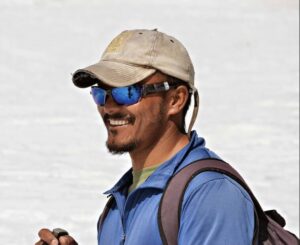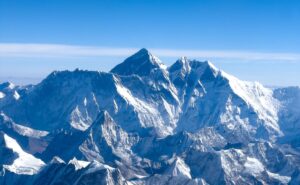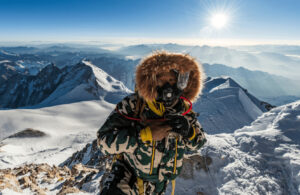“On Annapurna, you could feel the place was dangerous. On Dhaulagiri, loads and loads of snow to deal with. And on Makalu, the beginning of the summit push was terrifying.”
Thirty-six-year-old Kristin Harila‘s first mountain of note was a hike up Kilimanjaro in 2015. But the Norwegian athlete has won worldwide notice in the mountaineering community by climbing six Himalayan 8,000’ers in record time this spring.
She has quieted those skeptics who didn’t take her seriously at first. Still, she has a long way to go before completing her project of summiting all 14 8,000’ers in six months.
Right after climbing Makalu, she was waiting in Base Camp for the weather to clear so she could catch a helicopter to Kathmandu. Although she was about to fall asleep — and did so two seconds after finishing this interview — Harila spoke to ExplorersWeb about her project. And she didn’t avoid some difficult questions.
“I am physically great, I could climb another mountain tomorrow,” the open and enthusiastic Harila said between bouts of coughing. She’d picked up the cough at Makalu Base Camp.

Harila and ‘Uncle Dawa’ on the summit of Makalu in bad weather. Photo: Kristin Harila
Harila admits that she didn’t have a lot of time to plan or train for this mega-endeavor. “I just came up with the project some months ago, so there was no time for thorough preparations.”
“Yet I think being 36 is better than being 20,” she said. “I am more experienced and have a long background of good training that I can draw on.”
A northern athlete
Born and raised in northern Norway, Harila‘s sports background unsurprisingly revolved around cross-country skiing. She competed at a national level from ages 16 to 23.
Beginning in 2013, she focused totally on her career. “I worked so much…too much,” she said. “I was an executive for an important Norwegian company, and I stopped training almost completely. Then in 2019, I decided I needed a change and quit my job. I took up cross-country skiing again (but didn’t compete), and did a lot of trail running.”
Climbing was not among her sports. “Northern Norway is totally flat. There are no mountains to climb!”

Still looking fresh on Annapurna, her first peak this spring.
After Harila went up Kilimanjaro in 2015, she caught the climbing bug. She discovered the Himalaya in 2019 by summiting two trekking peaks, Lobuche East and Putha Hiunchuli (also known as Dhaulagiri VII).
“I decided I wanted to focus on mountains and do something big,” she explained. Her first idea was the Seven Summits. That’s when she first began to eye Everest.
“Then came the COVID pandemic and all plans stopped, but at least I was able to train intensely in Norway’s mountains,” she recalled. “They are not tall but offer endless possibilities for long routes.”
She also managed to climb Aconcagua in 2020.
Thinking bigger
In 2021, she joined a Madison Mountaineering team to Everest and Lhotse, which she summited. That was when the 14×8,000m project started.
“Back in Camp 2, people were celebrating the summit, but I couldn’t help feeling sad because it was over. So, I started thinking of new projects. Something bigger than the Seven Summits.”
Harila had seen Nirmal Purja speed up the 8,000’ers and decided that she would take his record as a challenge. When potential sponsors passed, she sold her apartment to finance the project.
“At the same time, I realized this sport and this industry [mountaineering] was far from equal,” Harila said. “On Everest, there were many more men than women. History speaks virtually only about men climbing mountains…I recall a brand I was speaking with, which was launching a new collection of super cool, cutting-edge, high-altitude clothes, and they only came in men’s sizes. The message is that girls may go hiking but not high-altitude climbing.”

Pasdawa, Harila, and Dawa Wongchu received a heroes’ welcome in Kathmandu.
“Likewise, on Everest, I noticed that the women in my team were well prepared mentally and physically, but the men were not, because their attitude was: Sure, I can do this.”
Sponsors didn’t believe me
When asked if Harila believes that would-be sponsors took her projects less seriously because she is a woman, Harila was clear: “Yes, I do. When I presented the project, they simply didn’t believe me. And now that I have come so far, many of these companies are contacting me to resume negotiations.”
Hence Harila’s “Women too” motto. It not only means that women can also climb, but that the outdoor industry should focus more on women.
“In the end, I do not care that much about beating a record, I care about inspiring young women. This is not about making the impossible possible, but proving that women can do it too. That they can do it even better.”
Although this message of empowerment is important, we noted that the number of women climbing Himalayan peaks has increased dramatically.
“It is true, I saw this, especially on Annapurna. It is great news, and some of these girls are remarkably young. [This is another] reason to pressure the industry.”

With fellow 8K expedition climber Purnima Shrestha of Nepal.
More about teamwork
Harila sees her project not as just an individual achievement, but as the result of coordinated, efficient teamwork.
“In this sense, I have a different narrative than the one in Purja’s film. This is not about one person doing something amazing. There are so many people involved! For me, it is essential to show the work that the Sherpas are doing. I have Pasdawa and Uncle Dawa [Dawa Wongchu is Pasdawa’s uncle] with me…I want to share the record with them because they deserve it so much. I hope they can complete the challenge with me.”
Besides her two Sherpa companions, Harila notes the work done by all those working in the mountains, from rope-fixing teams to porters. And of course, logistics teams, which are vital for this kind of project.

A team of three.
“Logistics have also been an essential part of the project, and 8K has done an amazing job. They are a new company, but the leaders are experienced and the Sherpa guides are so strong. They have engaged 100% with making my project happen.”
Not a walk in the park
Harila is using all the help that technology and human resources can provide: helicopters, O2, and support up the route.
“I am hiding nothing. The most important thing is to be open from the start about what you are doing,” she said. “For me, people can climb in whatever way they want but [should be] honest about how they do it. I am using oxygen, I don’t carry loads, I rely on Pasdawa and Uncle Dawa.”
Other factors cannot be controlled. “On Kangchenjunga, I was so sick [likely a stomach bug]. I had a really difficult summit push and it was long. On Annapurna, you could feel the place was dangerous. On Dhaulagiri, loads and loads of snow to deal with.
“And on Makalu, the beginning of the summit push was terrifying. We went out in complete darkness. It was snowing and the ropes were nowhere to be seen. But Pasdawa and Uncle Dawa just kept going, breaking trail in deep snow, upwards, non-stop. I was thinking: Oh my goodness, there are no ropes, what if we miss the route, I see nothing…And then, after hours, there were the ropes. They knew exactly where they were going and eventually found them.”
And on Everest?
“I don’t want to say that it’s a walk in the park but the roped-up trail on the upper sections is like a motorway!”

Challenges ahead
Harila hopes to keep the same Sherpa guides for the entire project. The second phase starts in two weeks on Nanga Parbat, then moves to the Karakoram 8,000’ers.
Continuing the project won’t be cheap. At present, sponsor Bremont pays for a fifth of the budget. Harila is footing the rest.
“We need to get some more sponsors, but now I am sure we will get them, and we have signed an agreement to make a film.”
For the project’s third leg, the hardest obstacles are not physical but bureaucratic. China remains closed to foreign expeditions, which could prevent Harila from summiting the final two peaks, Shishapangma and Cho Oyu.
“We have started the process of applying for a special permit and I am hopeful we will get it. Norway and China have often worked together in the past and I hope they’ll still find common ground. After all, Nirmal Purja obtained one, so I don’t see why I should not get equal treatment.”
It might be possible to summit Cho Oyu from Nepal if Harila joins the teams trying to open a commercial route up the SSW Ridge. But that would still leave Shishapangma.

Arriving in Base Camp at night after summiting Makalu.
Time will tell if she can tick off the upcoming 8,000’ers as swiftly as the first six. Did Harila think it was going to work out as well as this spring, at least, has gone?
“Yes, I was positive that I could make it, although I was also aware that we had to be lucky with the weather. But I actually didn’t think much about it. I just went one mountain at a time. And I will continue to do so with the other peaks.”






